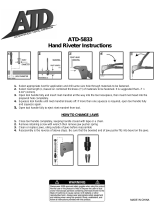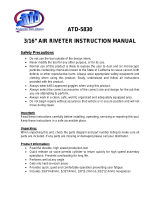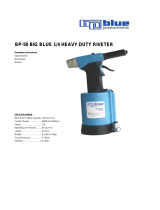
Overhaul:
The disassembly and reassembly procedure can be accomplished
by utilizing the following instructions and the drawings on pages
4 and 5. Use extreme care during disassembly and reassembly
not to mar, nick, of burr any smooth surface that comes in
contact with O-rings. Before installing O-rings, be sure to apply
a good rubber lubricant, such as Lubriplate, to the
surfaces. It is recommended that the special assembly tools
shown here be used to facilitate the overhaul.
Virtually all of the moving parts in this tool ride on O-rings,
protected by backup rings where high pressure dictates. This
means no metal to metal wear. By use of close tolerances and
low microinch surfaces against which the O-rings seal, a
long life can be expected before any overhaul becomes
necessary. At that time, a complete overhaul can be achieved
by the use of Service Kit G703KS, which contains a complete
set of O-rings, backup rings, screws, washers, and gaskets.
Air Bleed Valve:
To disassemble, first disconnect the tool from its air
source. Remove retaining ring (54) and muffler (53). Insert
a 5/16-18 threaded rod or bolt into end of valve plug (52)
and pull it out. Using the same procedure, pull out spool (48).
NOTE: It should never be necessary to remove valve sleeve
(45)
unless the ports in the sleeve are plugged up tightly
from contaminated air. The O-rings on this sleeve are static
and hence do not wear. If it is suspected that the ports are
plugged up, use needle nose pliers to grasp end of spring
(46), turning clockwise and pulling to dislodge from groove in
casting. With spring removed, valve sleeve (45) can be pulled
out using an 837B10 valve sleeve removal tool.
To reassemble, reverse the above procedure, being certain that
all O-rings are properly lubricated before installation. The spring
(46)
is best installed using an 836B10 spring inserting tool to
push the large diameter coil into the casting groove. This
requires care, as the tool will not operate if this spring is not
anchored firmly.
Handle:
To inspect the air cylinder bore, remove only parts 27
through 31. Any further disassembly will require removal of
the head assembly first.
For this complete disassembly, start by removing parts 27
through 31. Next, holding tool upright, remove four socket-
head cap screws (57). Lift head assembly from handle (34)
and set aside O-ring (56) and gasket (55). Empty all
hydraulic fluid into a container by pouring from the handle.
Place piston rod wrench 700A61 down into top of handle,
onto the hex head of the power piston (63). While holding
this wrench, remove the conelok nut (26) using a 7/16”
socket wrench. Still holding piston rod wrench, remove the
air piston (24) using packing plug wrench 700B65, by
turning counterclockwise. When the air piston is completely
freed from the piston rod, tap or push on the piston rod
wrench to eject piston from the bottom of the handle.
After the removal of the air piston, slide piston rod (63)
back up to the end of its travel. Using the packing plug
wrench remove packing plug (20). It may be necessary to
hold the handle upside down in a vise while loosening the
packing plug. With packing plug removed, the power
cylinder (36) can be tapped out by lowering the power
cylinder tool down into the top of the handle onto the top of
the cylinder. The O-rings and backup rings (17 & 18) are
best removed (and replaced) by using a thin, bent hook.
Care must be taken to avoid damaging the O-ring grooves
or cylinder.
Head:
Always remove the complete pulling head from the tool
before attempting disassembly of head body.
Remove end cap (11). Seal tube (9) comes out with cap as
it is held in place by two retaining rings (10). These need
not be removed.
Push against threaded end of head piston (4) to slide it out
of head body (1). Be careful not to damage threads or
cause burrs on polished piston rod surface. O-rings (2) and
backup ring (3) can now be removed using a bent hook. O-
rings (8) can be removed in the same manner.
Upon reassembly, be sure to install O-rings and backup
rings carefully to avoid cutting them. Also, always lubricate
any O- rings with Lubriplate. The reassembly sequence is
the opposite of disassembly. This includes filling the handle
(34) with hydraulic fluid before replacing gasket (55) and
O-ring (56), just prior to replacing head assembly. (See oil
filling instructions.)
Tighten the four socket-head cap screws (57) uniformly to
prevent leakage around the gasket. When assembled,
purge the system of air by using Avdel Cherry air bleeder
700A77 according to instructions included with bleeder.
(See oil filling instructions.)
6














